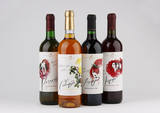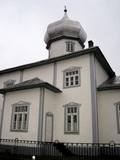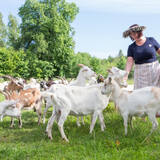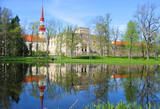| Нo | Название | Описание |
|---|---|---|
|
Находится к югу от Екабпилса, в северо-восточной части песчано-гравийного карьера Раджу (водохранилище Раджу). Интересно, что камень найден во время разработки карьера. Камень Раджу оценивается как второй по величине валун Латвии (объем ~ 100 м3). В северной части карьера создан Екабпилсский лесопарк – популярнейшее место для прогулок, отдыха и занятий спортом горожан. В 2012 году пляжу водохранилища Раджу присвоен «Голубой флаг». |
||
|
В хозяйстве из местных продуктов и без консервантов производят домашнее вино (фруктовое, ягодное, из цветов одуванчика), интересное варенье (пикантный сливовый соус и др.), фруктовые и ягодные консервы. Для туристических групп предлагаются экскурсии, дегустации и приобретение продукции. |
||
|
Кемпинг «Klintis» на самом берегу моря у скал Вецземью предлагает парковку, палатки и места для пикника со скамейками, столиками, грилем, возможность купить дрова. Для гостей кемпинга есть хорошо оборудованные кемпинговые домики, места для отдыхающих, душевые и туалеты. На территории кемпинга есть ресторан Rankuļrags и летнее кафе. Для юных гостей оборудована игровая площадка. |
||
|
A haven for Russian Old Believers. Mustvee village has held fairs for the past two centuries. It is also a traditional fishing town. |
||
|
Atrodas 1905. gada ielā 6. Sinagoga tika celta 1875. g. – Krievijas cara Aleksandra II valdīšanas laikā. Pēc 2. pasaules kara tajā atradās graudu noliktava, kinoteātris, kafejnīca un visbeidzot – naktsklubs. No 2003. gada to vairs neizmantoja. Pirms gada tika pabeigts vērienīgs projekts - sinagogas un lūgšanu nama atjaunošana, kurā izveidots sabiedrībai pieejams kultūras un informācijas centrs un pārcelta Kuldīgas novada bibliotēka. |
||
|
Iepazīstina ar Somā nacionālā parka lielākā purva – Kureso (Kuresoo) ziemeļaustrumu daļu, kur redzamas purva ezeriņu un lāmu ainavas. Takas sākumā atrodas igauņu komponista, ērģelnieka un folkloras vācēja Marta Sāra (Mart Saar) (1882. – 1963.) dzimtās mājas. To apkaimē pļavas apsaimnieko aitas. Lokveida takas garums ir 4,2 km. |
||
|
В поместье Попеc одним из старейших зданий комплекса является старый замок или охотничий замок, построенный в 1653 году и расположенный за прудом с укрепленными берегами. В нем сохранилась деревянная лестница, ведущая на второй этаж. Господский дом был построен в 1608 или 1620 году. Позже было пристроено кухонное здание, которое с господским домом соединяет дом для прислуги. В конце 17-го века, дом хоть и перестроен, однако все еще является одноэтажным зданием. На рубеже веков здание было вновь перестроено, в результате чего оно превратилось в шикарный замок с 78 стеклянными окнами, что в то время было большой роскошью. В 1840 году было добавлено неоготическое крыльцо. В господском доме сохранилась отделка интерьера 18-го – конца 19-го века - деревянные панели, кассетный деревянный потолок, пластичная отделка потолока, входная дверь в стиле классицизма, печь в стиле рококо. К сожалению, в 2018 году в результате пожара было разрушено одно из старейших зданий – дом управляющего поместьем, однако, в целом, усадебный комплекс не пострадал и не утратил своей красоты. Здесь посетителей радует большой и ароматный сад флоксов в передней части усадьбы и впечатляющие вековые дубы. Стоит прогуляться по склону за главным зданием особняка - неподалеку проходила узкоколейная железная дорога (станция Попе). После ледникового периода, когда здесь плескалось Балтийское озеро, возвышенность Попе, на котором находится комплекс усадьбы, какое-то время была островом. Другие усадебные дома расположены на довольно большом расстоянии, поэтому стоит запланировать несколько часов и осмотреть все село Попе. |
||
|
Starp steķiem un Tūjas ķieģeļu fabriku bija
izveidots sliežu ceļš, pa kuru transportēja labākās kvalitātes ķieģeļus.
Pēckara gados „Dzeņu” krastā uzcēla zivju pārstrādes rūpnīcu, bet pāri
steķiem – cauruli, pa kuru ar ventilatora palīdzību sūknēja zivis no kuģiem,
kas bija piestājuši steķu galā.
|
||
|
Atrodas Skolas ielā 12, Priekules pamatskolā. Tās krājumā ir plašs Priekules novadā iegūto vēsturisko liecību klāsts – sadzīves priekšmeti, darbarīki, dokumenti, padomju gados izsūtīto un represēto cilvēku atmiņu stāsti u.c. liecības, kā arī Priekules skolu attīstības vēsture. |
||
|
Латышский сельский двор, на котором пасутся около 50 коз. Предлагает экскурсии по хозяйству и приобретение сыра. Сыр можно приобрести и на базарчике в Страупе. |
||
|
Усадебный комплекс Швекшна представляет собой один из красивейших архитектурных ансамблей во всей Жемайтии. Вокруг усадьбы разбит великолепный парк. Обе части парка соединены широкой парадной лестницей, украшенной вазами. С лестницы открывается прекрасная панорама водоемов нижней террасы. На острове посреди центрального усадебного пруда все еще стоит скульптура богини Дианы. На главной аллее парка восстановлены нарядные солнечные часы, ваза на пьедестале, статуя Св. Марии, скульптура «Ангел свободы». Также были отреставрированы и другие элементы парка — обзорные площадки, тропинки, ворота. |
||
|
Хозяева выращивают шиншилл (родина шиншилл – горы Анды Южной Америки). Предлагают экскурсию и рассказ о жизни и выращивании шиншилл, приобретение животных и шкурок. Хозяйка пишет картины. |
||
|
Семейное предприятие, расположенное в Яунаннинской волости Алуксненского края, которое занимается производством кулинарных и кондитерских изделий. Вкусные мясные рулеты и ролады, приготовленные по бабушкиным рецептам, другие мясные изделия в широком ассортименте, а также особые кондитерские изделия производства Gustiņš можно купить в Алуксне ‒ в «Лавке вкусов Gustiņš». В кафе Gustiņš можно отведать сытной, вкусной, действительно домашней еды и попробовать типичные для Алуксненского края блюда ‒ подав предварительно заявку. |
||
|
Lauku sēta ar pirti atrodas Merkys upes krastā, ciema nomalē meža tuvumā. Piedāvā programmu "Griķu ceļš no sēklas līdz galdam", iespējams nobaudīt tradicionālos ēdienus. Piedāvā arī nakšņošanu. |
||
|
Eine der malerischischen Burgberge am Fluss Nemunas mit schöner Sicht aufs Flusstal. In 13 – 14 Jh. befand sich hier eine militäre Festung, die nicht erhalten ist. |
||
|
There are three craters here, and the biggest one, known locally as Põrguhaud, or Grave of Hell, has a diameter of 80 m and a depth of up to 12 m. There are barriers around the crater that are several metres high. The other two craters are hard to spot. The craters around 6,000 years old. No scraps of the supposed meteorite have been found, however, and so the origins of the craters cannot be confirmed with certainty.
|
||
|
Находится в красивом месте – в южной части острова Пилс возле пешеходного моста через реку Дрикса. |
||
|
На ферме проводятся эдукационные занятия, во время которых посетителям демонстрируют животных, содержащихся на ферме, уход за ними, знакомят с происхождением пород. Для посетителей имеется возможность самим собрать яйца или научиться правильно сидеть в седле, а также покататься верхом. |
||
|
Победитель 1-го конкурса пекарей печет ржаной хлеб по традиционному рецепту, используя ржаную муку, смолотую на мельнице Сангасте. |
||
|
Каменная крепость Пыльтсамаа была построена на берегу реки в 13-ом веке, в 16-ом веке крепость была резиденцией короля Лифляндии Магнуса. Во дворе крепости находятся туристический информационный пункт и музей Пыльтсамаа, винный погреб с Музеем продуктов питания, Эстонский музей прессы, галерея pART, гончарная и ремесленная мастерские. |
||

























